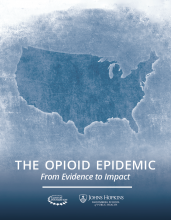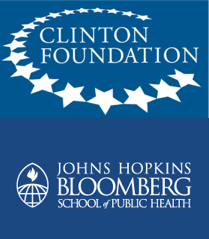Did the Hopkins-Clinton Foundation “Opioid Epidemic” report include integrative approaches?
November 30, 2017
 by John Weeks, Publisher/Editor of The Integrator Blog News and Reports Editor’s note: This analysis article is not edited and the authors are solely responsible for the content. The views and opinions expressed in this article are those of the authors and do not necessarily reflect the official policy or position of Integrative Practitioner. The Clinton Foundation and Johns Hopkins Bloomberg School of Public Health recently updated recommendations via their partnership on the nation’s chronic pain treatment crisis in The Opioid Epidemic: From Evidence to Impact. Integrative and even more limited “non-pharmacologic” strategies figure into one key section, yet are virtually absent in other segments of the action plan. The Hopkins-Clinton authors announce a commitment to the same three principles that motivated the 2014 and present reports: Informing Action with Evidence; Intervening Comprehensively; and Promoting Appropriate and Safe Use of Prescription Opioids. The authors announce an intention to be “intervening comprehensively” noting that all “effective primary, secondary, and tertiary prevention strategies are vital.”
by John Weeks, Publisher/Editor of The Integrator Blog News and Reports Editor’s note: This analysis article is not edited and the authors are solely responsible for the content. The views and opinions expressed in this article are those of the authors and do not necessarily reflect the official policy or position of Integrative Practitioner. The Clinton Foundation and Johns Hopkins Bloomberg School of Public Health recently updated recommendations via their partnership on the nation’s chronic pain treatment crisis in The Opioid Epidemic: From Evidence to Impact. Integrative and even more limited “non-pharmacologic” strategies figure into one key section, yet are virtually absent in other segments of the action plan. The Hopkins-Clinton authors announce a commitment to the same three principles that motivated the 2014 and present reports: Informing Action with Evidence; Intervening Comprehensively; and Promoting Appropriate and Safe Use of Prescription Opioids. The authors announce an intention to be “intervening comprehensively” noting that all “effective primary, secondary, and tertiary prevention strategies are vital.”  With this intention, the authors announce plans to take a “fresh-look” for “updating the evidence-base and timeliness of prior recommendations.” Such a context suggests potential for significant alignment with robust activity in the 2014-2017 time-frame that has shifted the scientific consensus toward an expanded list of integrative approaches for pain. Multiple parties, including the National Academy of Medicine, the Joint Commission, and American College of Physicians and others have a growing alignment. The period has also marked significant adoption of integrative approaches to pain in the Veterans Administration and the Department of Defense. The report offers 48 recommendations in 9 discrete areas. These are endorsed by a list of 28 signatories. (Notably the page-long list lacks representation of any well-known representative of the integrative health and medicine community.) What do we find? Integrative strategies get their most explicit mention in the introduction to Section 2, “Standardizing Clinical Guidelines.” Emerging recommendations of non-pharmacologic approaches for non-cancer chronic pain are highlighted in the introduction. The authors clarify: “There are also many non-pharmacologic therapies that can be used for the management of pain, including physical therapy, therapeutic massage, acupuncture, biofeedback, yoga, and heat or cold therapies.” They point to the Center for Disease Control’s 2016 Guideline for Prescribing Opioids for Chronic Pain. This is a document that, while also urging non-pharmacologic approaches, was inexplicably cleansed of references to acupuncture, massage and chiropractic when it moved from draft to final version. Mention was limited to “exercise, aquatic, aerobic, psychological, cognitive behavioral therapy, and biopsychosocial interventions.”
With this intention, the authors announce plans to take a “fresh-look” for “updating the evidence-base and timeliness of prior recommendations.” Such a context suggests potential for significant alignment with robust activity in the 2014-2017 time-frame that has shifted the scientific consensus toward an expanded list of integrative approaches for pain. Multiple parties, including the National Academy of Medicine, the Joint Commission, and American College of Physicians and others have a growing alignment. The period has also marked significant adoption of integrative approaches to pain in the Veterans Administration and the Department of Defense. The report offers 48 recommendations in 9 discrete areas. These are endorsed by a list of 28 signatories. (Notably the page-long list lacks representation of any well-known representative of the integrative health and medicine community.) What do we find? Integrative strategies get their most explicit mention in the introduction to Section 2, “Standardizing Clinical Guidelines.” Emerging recommendations of non-pharmacologic approaches for non-cancer chronic pain are highlighted in the introduction. The authors clarify: “There are also many non-pharmacologic therapies that can be used for the management of pain, including physical therapy, therapeutic massage, acupuncture, biofeedback, yoga, and heat or cold therapies.” They point to the Center for Disease Control’s 2016 Guideline for Prescribing Opioids for Chronic Pain. This is a document that, while also urging non-pharmacologic approaches, was inexplicably cleansed of references to acupuncture, massage and chiropractic when it moved from draft to final version. Mention was limited to “exercise, aquatic, aerobic, psychological, cognitive behavioral therapy, and biopsychosocial interventions.”  This section of the Clinton-Hopkins report also urged payers to “invest in care models for chronic pain that emphasize non-pharmacologic treatments as well as collaborative care by different medical specialties and non-physician caregivers.” Improving coverage for such services is linked to a transition from long-term opioid use. The rest of the 59-page document and 8 other section then largely forgets the topic. A section on education of providers includes no recommendations that they be educated on how to refer for integrative options. Content on “Patient and Public Education” includes a hopeful reference to “alternatives” in the opening. Yet it only returns to the theme to suggest public education about an unspecified list of “alternatives for pain management.” A section on “Harm Reduction Strategies” is utterly silent to the potential of a re-prioritization of chronic pain treatment in reducing harm of opioids. The focus instead is on such methods as needle exchanges and naloxone distribution programs. In “Treating Opioid Disorders” nothing suggests the value or importance of non-pharma approaches. Similarly, a segment on “Identifying and Treating People with Opioid Use Disorders” did not reference non-pharmacologic therapies. It gave a nod to value in psychosocial programs such as behavioral health, community models and 12 step programs. Yet the authors highlighted the latter’s failure to meet the reductive scientist’s bar ((what is the active agent): “While 12-step programs are valued by many addiction professionals, it has been difficult to determine which elements of these programs may be of greatest therapeutic value.” Comment: Slowly the integrative and non-pharmacologic seeps in. Yet this Hopkins-Clinton Foundation report puts non-pharma in a static role, a value given lip-service on one’s Holy Day – “non-pharma should come first” - then all but forgotten the rest of the week. Why were these approaches and practitioners not better included in specific strategies around public, clinical, patient, harm reduction, to create change? This report needs an addendum to fill out the missing areas of action needed to foment the shift toward more non-pharmacologic treatment. The Clinton Foundation might partner with the Academy of Integrative Pain Management that just 50 organization pain policy summit, the and Integrative Health Policy Consortium with AIPM to bring the expertise to the table that was not evident among the signatories. What for instance might the best public education campaign look like from an integrative-respectful perspective? How about clinician education? One starting place would be to include the handy one-pager the 4 integrative organizations collaborated to develop called Moving Beyond Medications. Optimal strategies for spreading the noted value of non-pharma by inlaying these modalities and providers into the action plans of the other sections requires the input of experts. One might have hoped, given Hillary Clinton’s sometime connection to the integrative universe, that more consideration might have been present.
This section of the Clinton-Hopkins report also urged payers to “invest in care models for chronic pain that emphasize non-pharmacologic treatments as well as collaborative care by different medical specialties and non-physician caregivers.” Improving coverage for such services is linked to a transition from long-term opioid use. The rest of the 59-page document and 8 other section then largely forgets the topic. A section on education of providers includes no recommendations that they be educated on how to refer for integrative options. Content on “Patient and Public Education” includes a hopeful reference to “alternatives” in the opening. Yet it only returns to the theme to suggest public education about an unspecified list of “alternatives for pain management.” A section on “Harm Reduction Strategies” is utterly silent to the potential of a re-prioritization of chronic pain treatment in reducing harm of opioids. The focus instead is on such methods as needle exchanges and naloxone distribution programs. In “Treating Opioid Disorders” nothing suggests the value or importance of non-pharma approaches. Similarly, a segment on “Identifying and Treating People with Opioid Use Disorders” did not reference non-pharmacologic therapies. It gave a nod to value in psychosocial programs such as behavioral health, community models and 12 step programs. Yet the authors highlighted the latter’s failure to meet the reductive scientist’s bar ((what is the active agent): “While 12-step programs are valued by many addiction professionals, it has been difficult to determine which elements of these programs may be of greatest therapeutic value.” Comment: Slowly the integrative and non-pharmacologic seeps in. Yet this Hopkins-Clinton Foundation report puts non-pharma in a static role, a value given lip-service on one’s Holy Day – “non-pharma should come first” - then all but forgotten the rest of the week. Why were these approaches and practitioners not better included in specific strategies around public, clinical, patient, harm reduction, to create change? This report needs an addendum to fill out the missing areas of action needed to foment the shift toward more non-pharmacologic treatment. The Clinton Foundation might partner with the Academy of Integrative Pain Management that just 50 organization pain policy summit, the and Integrative Health Policy Consortium with AIPM to bring the expertise to the table that was not evident among the signatories. What for instance might the best public education campaign look like from an integrative-respectful perspective? How about clinician education? One starting place would be to include the handy one-pager the 4 integrative organizations collaborated to develop called Moving Beyond Medications. Optimal strategies for spreading the noted value of non-pharma by inlaying these modalities and providers into the action plans of the other sections requires the input of experts. One might have hoped, given Hillary Clinton’s sometime connection to the integrative universe, that more consideration might have been present.



















SHARE